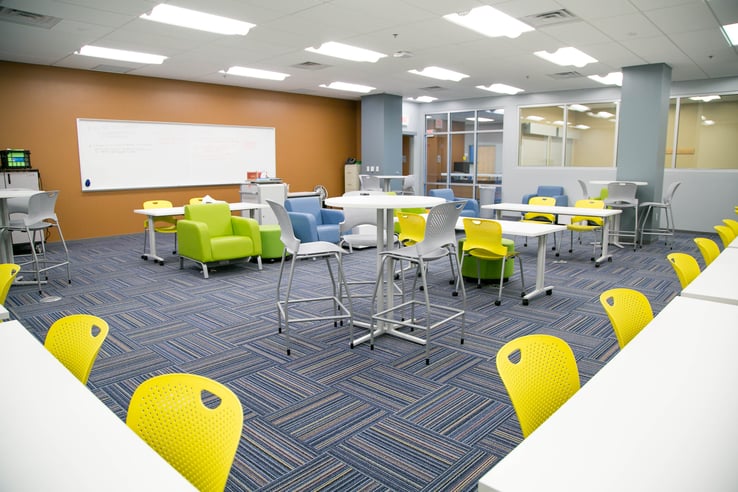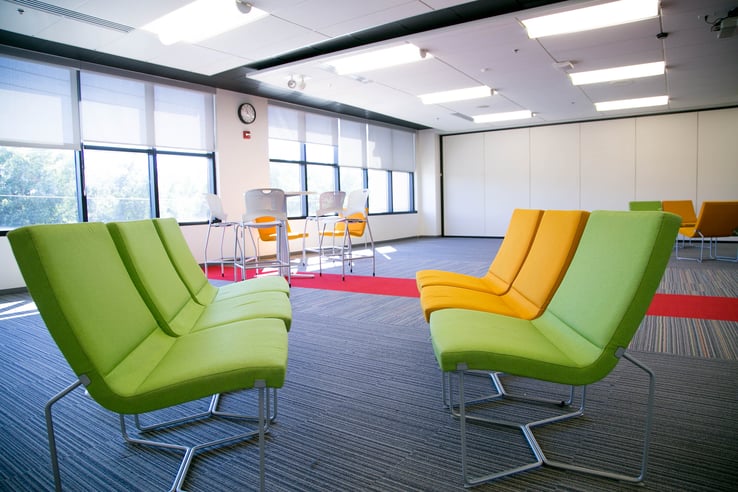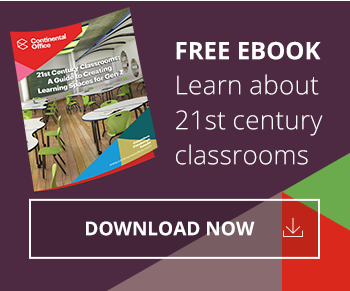We recently had the chance to sit down with the renowned school leadership and training consultant, Mark White, to pick his brain about education reform and the changing classroom design landscape. Below is our conversation.
What prompted you to take the leap and start looking at space differently?
When we built Clark Hall we had a rare opportunity to build a building from the ground up. We said to ourselves let’s not build a building for yesterday’s students, what do kids want today? In our minds the building should be built for these kids and how they learn. Today’s generation needs choices – in furniture, colors, natural lighting, and movement. Every space should be a learning space, even the hallway.
What surprised you most when you were creating Clark Hall? Any ah-ha moments that truly stand out?
We built a lot of the rooms in a very innovative and cool way, and we also built a few traditional classrooms. Looking back, I wish we would have built the entire building in a fun way. Learning spaces today need to not only foster creativity but inspire a sense of awe. They need to mirror the way the world is today. When a student walks into a learning space, it should be a place they want to be.
What results/reactions have you seen as you’ve watched students engage and learn at Clark Hall?
I’ve seen the importance of learning spaces on student achievement and how environment has helped students to become more successful. Students say Clark Hall is relaxing. Today’s generation wants an environment like Starbucks, where they can get comfortable and customize their experience.

How did you come to the conclusion that 21st century teaching is a state of mind (and more than just a space)?
The days of teachers standing in front of straight rows of students disseminating information are over. Teachers today need to equip their students with 5 core skills: creativity, collaboration, critical thinking, communication, and culture. These global skills along with technology are what bring teaching into the 21st century.
Was it difficult to get into this 21st century teaching mindset?
We were ready to embrace it! Educators have to embrace it too, and faster than the generations before them.
What advice would you give to teachers/educators who are starting out on this journey?
You must be comfortable with being uncomfortable. Now more than ever, your students are your partners. You have to realize that how you’re teaching when you finish your career will be very different than how you’re teaching now. Have an open mindset and be ready to change, because the changes are not going to stop. Imagine a future where whatever you think of as magic right now will happen.
What do you think the biggest challenge for teachers/educators is in 21st century teaching?
Students will continue to evolve and change over the years. Educators who don’t put an emphasis on global skills will leave their students at a disadvantage. They must also keep up with technology by knowing what’s out there. And finally, space can be a challenge. Your space and furniture has to be flexible and multi-functional to accommodate not only this generation but the next. Schools in the future will not look like they do now and if they do, it’s likely those schools will be out of business.
What do teachers/educators need to know about Generation Z?
Today’s students are the first generation to grow up with swipe screens. Research shows that their brains are wired differently as they have been exposed to so much technology earlier than any other generation before them. They are used to choices and using technology for everything. Schools are the only place they go where they are required to write with a pen and paper. Not that students can’t still learn in this way, but it’s certainly no longer the most effective way. Educators who evolve and adapt their teaching for this generation will enable their students to learn at a much higher level and tap into their full potential.
Has social media changed student expectations/the way they learn?
Students today share everything via social media, not just opinions but also the things they’re learning. They text each other constantly, sometimes even providing lesson material and test answers to their classmates, which makes it much more difficult to give a traditional assessment from period to period. We have so much information that is “out there” on the internet, it begs the question what does it mean to be educated anymore? And how much memorization of material can we reasonably expect in schools? It’s not about what you learn anymore, but rather about how you apply that knowledge. Assessments should be based on creativity and problem solving—and learning spaces can foster those things.
How can learning spaces reflect these changes?
Embrace these changes and don’t fight them. Many teachers now set up Facebook groups for their classes or text their students a reminder to study the night before a test. Involve your students, staff, and community in the redesign of your spaces. If only those at the top are making the decisions, the rest won’t understand why changes are being made or be able to embrace them fully. Make sure you always understand and can explain why you and your stakeholders are making changes to your spaces.

In your book, you say that Gen Z isn’t necessarily addicted to their cell phone device, rather they are addicted to connection. Does this carry through to their interaction in the physical space?
To Gen Z, their phone is more than a phone – it’s their world. That’s why when it’s taken away, they go a little nuts, because it’s like they’ve been disconnected. Gen Z is a very connected generation and wants to be. That’s why we have to develop spaces where they can connect in person and online, with someone down the hallway or halfway around the world.
What impact will space have on learners in the future?
Based on everything I am seeing today, schools will begin to catch up on space and we will see a widening gap between new types of spaces built for today’s learners and traditional spaces where schools haven’t done anything to change. Students today will never be as good as they can be without great spaces.
What would you say to educators who have concerns that they may be needed less as technology and online learning advances?
Go with the flow. Educators will still be needed but for different things. Instead of lecturing, teachers today need to be facilitating. Instead of giving students the facts, they need to help them find the facts. Students will always need good, moral, and educated guides.
Lastly, we’ve heard you’re coming out with a second book! What can we expect to learn and see?
I’m writing with Dwight Carter, the principal of New Albany High School, about the 8 disruptions that are reshaping American schools today. Our schools are judged by their test scores, but we believe there are some other factors that need to be given a closer look.





Comments